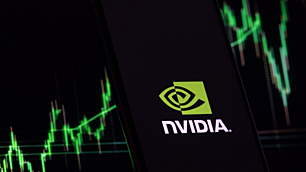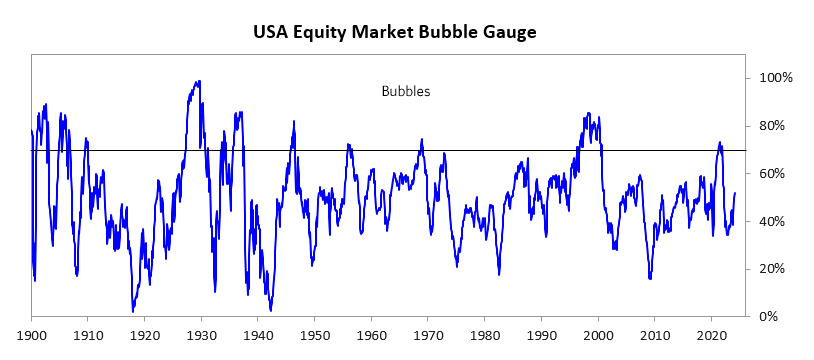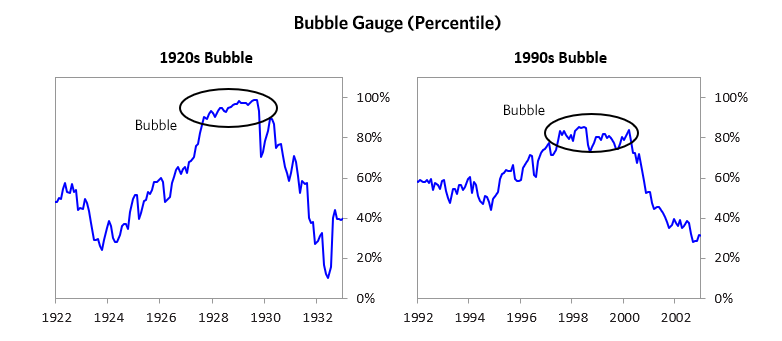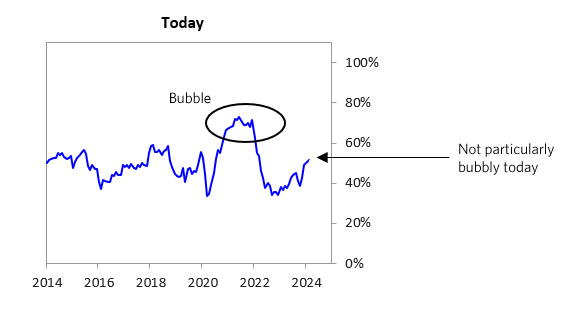Ray Dalio's bubble insights: is the bull run sustainable?
With markets rallying strongly in recent months amid expectations of rate cuts, and US and Aussie indices hitting all-time highs along with gold and bitcoin, it has prompted the question "are we in a bubble?"
In some cases, the question has been confined to certain parts of the market, i.e. "The Magnificent Seven" but, either way, the dreaded "b" word wasn't in the vernacular just a few months ago.
In the following wire, I summarise some of the recent commentary regarding bubbles on the Livewire platform, as well as from world-renowned investor Ray Dalio.
Tom Stevenson, Fidelity International
Stevenson recently wrote a wire and highlighted the similarities between today's market and that of 1999 and the dotcom bubble:
"The echoes of 1999 are all around us, although there are some important differences too. The similarities include a narrow market leadership - the so-called Magnificent Seven group of leading tech shares that includes Nvidia accounts for around half of the S&P 500’s gains so far in 2024.
Collectively, the companies represent a quarter of the value of the US stock market. The market 25 years ago was similarly dominated by a handful of internet-related stocks, including Cisco", said Stevenson
He then went on to highlight five indicators for measuring bubbles, including:
- the widespread adoption of a ‘new economy’ story
- a generational divide that drives a wedge between old guys like me who ‘don’t get it’ and young believers who do
- invention of a new set of metrics that fit the bullish case better
- prices that continue to rise even when news flow turns negative
- investors, flush with their stock market gains, look for opportunities in other risky assets. Watch out for new asset classes to emerge
Following the analysis - which I highly recommend you read in full - Stevenson reached the following conclusion:
"I think that if we are in a bubble, it is still young.
The valuation premium is well short of the level reached in 1999 or even in the early 1970s when the most popular shares were priced nearly twice as expensively as the rest of the pack.
We are a long way off that today. The sentiment is not yet universally positive. When it becomes so, it will be time to worry. We’re not there yet".

Justin Lin, GlobalX ETFs
Lin recently wrote a piece for Livewire, focusing solely on Nvidia - the current posted child for bubbly growth stocks.
Of Nvdia, Lin said the following:
"Nvidia has just hit a new all-time high of US$603.31, marking a 12-month return of 210% and a total market cap of more than US$1.3 trillion. With such immense growth, questions have naturally arisen about overvaluation. It is our view that, despite Nvidia’s dizzying rally over the past year, there is no clear evidence of a bubble. Evidence suggests the rally has been driven by the market pricing-in consensus future earnings rather than by hype.
Lin then went on to break down, in significant detail, the drivers of Nvidia's growth for the next few years. Following that, Lin came to the following conclusion;
While Nvidia has certainly had an impressive run over the past 12 months, we believe the valuation for the stock remains realistic and is rooted in fundamentals.
Lin goes on to say that a strong earnings outlook, high market demand, an extensive technological moat, and growing AI adoption are all factors that we see driving Nvidia forward in the coming years.
As such, it is our view that Nvidia continues to be one of the best companies to capitalise on the growth of artificial intelligence and should not be considered to be ‘in a bubble'.

Ray Dalio
For those unfamiliar, Bridgewater founder Ray Dalio is one of the most successful hedge fund managers of all time. With a net worth of around USD$15 billion, Dalio has many well-known investment stories and helped bring McDonalds chicken nuggets into existence.
Dalio regularly writes about bubbles, having studied them intensely over his investing career. He cites the following factors when considering bubbles (please note, this information was sourced from a social media post by Dalio himself - the full version is available here)
Dalio defines a bubble market as one that has a combination of the following in high degrees:
- High prices relative to traditional measures of value (e.g., by taking the present value of their cash flows for the duration of the asset and comparing it with their interest rates).
- Unsustainable conditions (e.g., extrapolating past revenue and earnings growth rates late in the cycle when capacity limits mean that that growth can’t be sustained).
- Many new and naïve buyers are attracted because the market has gone up a lot, so it’s perceived as a hot market.
- Broad bullish sentiment.
- A high percentage of purchases financed by debt.
- A lot of forward and speculative purchases made to bet on price gains (for example, inventories that are more than needed, contracted forward purchases).
Dalio goes on to explain why he doesn't think US markets are in a bubble right now.
"I apply these criteria to all markets to see if they’re in bubbles. When I look at the US stock market using these criteria (see the chart below), it—and even some of the parts that have rallied the most and gotten media attention—doesn’t look very bubbly. The market as a whole is in the mid-range (52nd percentile)."
As shown in the charts, these levels are not consistent
with past bubbles.



More from Dalio:
"The “Magnificent 7” has driven a meaningful share of the gains in US equities over the past year. The market cap of the basket has increased by over 80% since January 2023, and these companies now constitute over 25% of the S&P 500 market cap.
The Mag-7 is measured to be a bit frothy but not in a full-on bubble.
Valuations are slightly expensive given current and projected earnings, sentiment is bullish but doesn’t look excessively so, and we do not see excessive leverage or a flood of new and naïve buyers. That said, one could still imagine a significant correction in these names if generative AI does not live up to the priced-in impact".
Conclusion
Whilst bubbles are almost impossible to predict and are usually only identified after the fact, in each case above, there has been some significant investigation and consideration as to whether the current environment has the hallmarks of a bubble.
In each case, that answer is a resounding 'no'.
All that said, I'll leave you with this message from the end of Dalio's post:
We wanted to pass along our updated readings on our bubble measure to you in light of the large rally in US equities and questions I have gotten from readers. What you do with this is up to you.
3 topics
2 contributors mentioned

